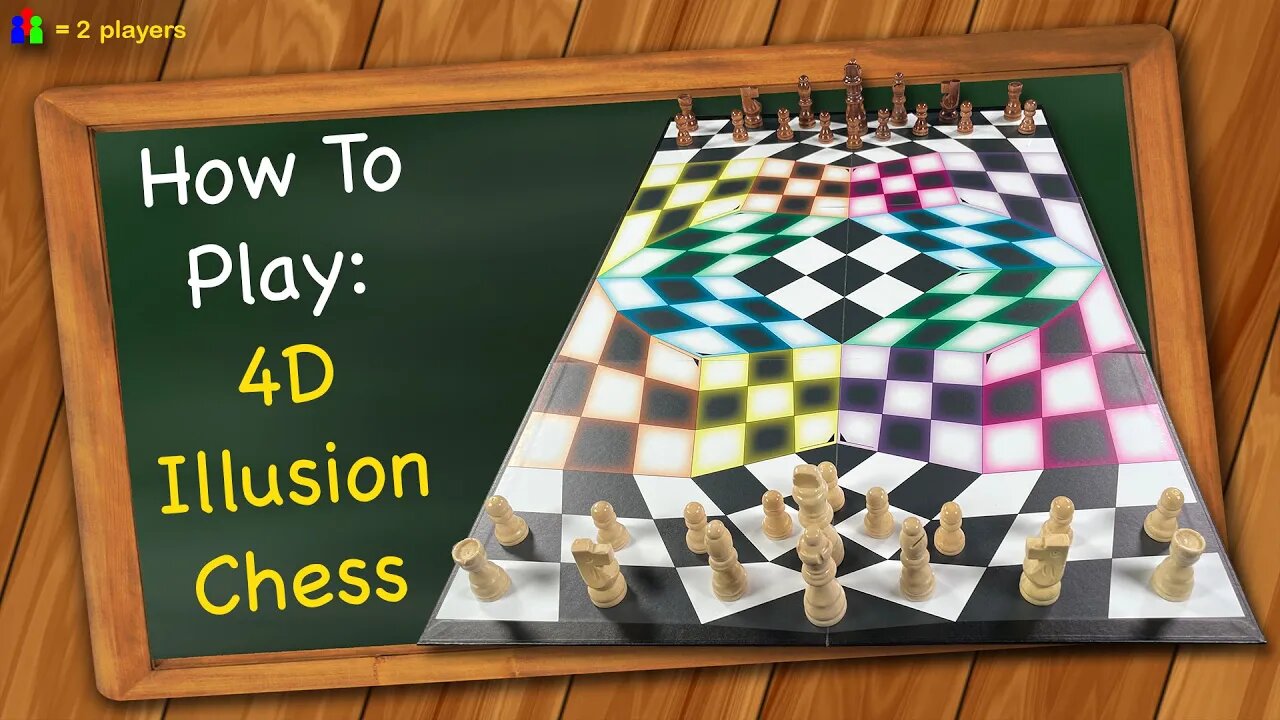Premium Only Content

How to play 4D Illusion Chess
Learn the rules to the chess variant game 4D Illusion Chess quickly and concisely - This video has no distractions, just the rules. For a refresher of the original rules of Chess, check out this video: https://youtu.be/iPXcfS0UDlI
Buy a 4D Illusion Chess board here: https://buy.triplesgames.com/4DillusionChess
Buy Double-Sided Chess Discs here: https://buy.triplesgames.com/DoubleSidedChessDiscs
You will need extra material in order to play, up to a complete extra set.
Don't own regular chess Buy it here:
amazon.com - https://amzn.to/2RMQwtO
amazon.ca - https://amzn.to/3gCiKDV
amazon.uk - https://amzn.to/3Gi02iG
amazon.es - https://amzn.to/3MiurhD
amazon.de - https://amzn.to/3MkqskD
amazon.fr - https://amzn.to/3MenpKR
amazon.it - https://amzn.to/3MeB6JR
amazon.nl - https://amzn.to/3Cl9D4s
amazon.se - https://amzn.to/3MiuoSZ
amazon.pl - https://amzn.to/3RMHFV8
amazon.com.br - https://amzn.to/3VeYoU6
amazon.sg - https://amzn.to/3HAqZya
amazon.au - https://amzn.to/3HzmvI7
amazon.co.jp - https://amzn.to/3XH24yE
(As an Amazon Affiliate, I earn from qualifying purchases)
RULES:
The rules are the same as regular chess except for these changes. The object of the game is to capture your opponent’s king, there is no check or checkmate. Layout the board longways between the two players. Each space on the board is considered a square, regardless of its perceived shape. On your 2nd row setup 9 pawns like so. On your first-row setup: rook, knight, bishop, king, bishop, knight, rook. On your bottom-most bonus square, place your queen.
Squares along the edge of the board are not diagonally connected to each other. Squares inside the board are only diagonally connected to the corners of adjacent squares that are not orthogonally adjacent to it. In certain locations, this results in preventing further diagonal movement in a specific direction, while in other cases, it allows for multiple diagonal movement options.
Movement across multiple squares must always be in a straight continuous line, though the perception of that line may curve. A straight line is considered moving across a square to the opposite line, or corner, from where you entered. Moves strung together this way are considered straight, though they may curve across the board.
Colored squares are grouped into sets of 9, with each set having a matching-colored set on the other side of the board, making a pair. Each colored set is conjoined with its pair so that the 2 sets are considered a single set of 9 squares. Any piece to occupy a colored square actually occupies both colored squares in the same set simultaneously. Use the board markers to identify the correct orientation of the sets and add an extra identical piece marker to the square of the other set to indicate this.
A piece beginning its turn on a colored square, can move from either of its conjoined locations on the board. In a single move, a piece may travel through colored squares like it traditionally would, or, it may travel through a colored square’s conjoined location and continue in the same relative direction it was traveling. You may not perform an infinite move nor return to the space that you started on. When a piece on a colored square is captured, remove both copies of it from the board.
Pawns always move orthogonally forward towards their opponent’s side of the board. If a diagonal space is directly in front of it, then it may travel to either of the 2 orthogonally forward spaces or capture forward, right, or left. En passant is allowed like normal. Pawns promote like normal when reaching any of their opponent’s higher rank starting positions.
Castling is allowed like normal by moving the king 2 spaces towards the rook, then the rook to the other side. You may castle even if your king is threatened, and you may castle through a threatened space. Kings may move to a threatened space. The first player to capture their opponent’s king, wins.
-
 2:21
2:21
Triple S Games
1 year ago $0.06 earnedHow to play Cruise Pawns
961 -
 1:00:41
1:00:41
Timcast
1 hour agoTrump MOBILIZING National Guard In NATIONWIDE Crackdown
40.5K51 -
 LIVE
LIVE
Steven Crowder
3 hours ago🔴 Donald Trump Vs American Crime: Chicago is Next & Libs Are Freaking Out
22,319 watching -
 LIVE
LIVE
Sean Unpaved
36 minutes agoQuarterbacks, Coaches, & Contracts: Sanders' Draft Drama, Meyer vs. Harbaugh, & McLaurin's Big Deal
323 watching -
 LIVE
LIVE
Grant Stinchfield
10 minutes agoDemocrats Try to Turn California Into Predator Playground with Proposed "Child Predator Dream Bill"
203 watching -
 LIVE
LIVE
Rebel News
35 minutes agoCdn troops in Ukraine? Poilievre backs self-defence, Hamas thugs cancel Ottawa Pride | Rebel Roundup
357 watching -
 LIVE
LIVE
Neil McCoy-Ward
59 minutes ago⚠️ OUTRAGE! What They Just Announced For YOUR HOME!!! 🚨
66 watching -
 LIVE
LIVE
IrishBreakdown
2 hours agoNotre Dame and Miami Set To Reignite Intense Rivalry
70 watching -
 LIVE
LIVE
The Charlie Kirk Show
1 hour agoChicago Next! + The Blue Slip Problem | Sen. Tuberville, Alex Clark | 8.25.2025
3,355 watching -
 1:20:52
1:20:52
Benny Johnson
3 hours ago🚨Trump LIVE Now: Signs Executive Order ENDING Cashless Bail | Dem Cities PANIC, Which City NEXT?...
39K29